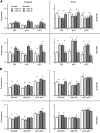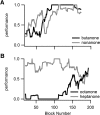A beta oscillation network in the rat olfactory system during a 2-alternative choice odor discrimination task
- PMID: 20538778
- PMCID: PMC2934938
- DOI: 10.1152/jn.00166.2010
A beta oscillation network in the rat olfactory system during a 2-alternative choice odor discrimination task
Abstract
We previously showed that in a two-alternative choice (2AC) task, olfactory bulb (OB) gamma oscillations (approximately 70 Hz in rats) were enhanced during discrimination of structurally similar odorants (fine discrimination) versus discrimination of dissimilar odorants (coarse discrimination). In other studies (mostly employing go/no-go tasks) in multiple labs, beta oscillations (15-35 Hz) dominate the local field potential (LFP) signal in olfactory areas during odor sampling. Here we analyzed the beta frequency band power and pairwise coherence in the 2AC task. We show that in a task dominated by gamma in the OB, beta oscillations are also present in three interconnected olfactory areas (OB and anterior and posterior pyriform cortex). Only the beta band showed consistently elevated coherence during odor sniffing across all odor pairs, classes (alcohols and ketones), and discrimination types (fine and coarse), with stronger effects in first than in final criterion sessions (>70% correct). In the first sessions for fine discrimination odor pairs, beta power for incorrect trials was the same as that for correct trials for the other odor in the pair. This pattern was not repeated in coarse discrimination, in which beta power was elevated for correct relative to incorrect trials. This difference between fine and coarse odor discriminations may relate to different behavioral strategies for learning to differentiate similar versus dissimilar odors. Phase analysis showed that the OB led both pyriform areas in the beta frequency band during odor sniffing. We conclude that the beta band may be the means by which information is transmitted from the OB to higher order areas, even though task specifics modify dominance of one frequency band over another within the OB.
Figures








Similar articles
-
Gamma and Beta Oscillations Define a Sequence of Neurocognitive Modes Present in Odor Processing.J Neurosci. 2016 Jul 20;36(29):7750-67. doi: 10.1523/JNEUROSCI.0569-16.2016. J Neurosci. 2016. PMID: 27445151 Free PMC article.
-
Directional coupling from the olfactory bulb to the hippocampus during a go/no-go odor discrimination task.J Neurophysiol. 2010 May;103(5):2633-41. doi: 10.1152/jn.01075.2009. Epub 2010 Feb 17. J Neurophysiol. 2010. PMID: 20164392 Free PMC article.
-
An olfacto-hippocampal network is dynamically involved in odor-discrimination learning.J Neurophysiol. 2007 Oct;98(4):2196-205. doi: 10.1152/jn.00524.2007. Epub 2007 Aug 15. J Neurophysiol. 2007. PMID: 17699692
-
Circuit oscillations in odor perception and memory.Prog Brain Res. 2014;208:223-51. doi: 10.1016/B978-0-444-63350-7.00009-7. Prog Brain Res. 2014. PMID: 24767485 Review.
-
[Involvement of the olfactory system in learning and memory: a close correlation between the olfactory deficit and the course of Alzheimer's disease?].Yakubutsu Seishin Kodo. 1991 Aug;11(4):223-35. Yakubutsu Seishin Kodo. 1991. PMID: 1799095 Review. Japanese.
Cited by
-
Sleep and olfactory cortical plasticity.Front Behav Neurosci. 2014 Apr 22;8:134. doi: 10.3389/fnbeh.2014.00134. eCollection 2014. Front Behav Neurosci. 2014. PMID: 24795585 Free PMC article. Review.
-
Dynamic cortical lateralization during olfactory discrimination learning.J Physiol. 2015 Apr 1;593(7):1701-14. doi: 10.1113/jphysiol.2014.288381. Epub 2015 Feb 16. J Physiol. 2015. PMID: 25604039 Free PMC article.
-
High beta rhythm amplitude in olfactory learning signs a well-consolidated and non-flexible behavioral state.Sci Rep. 2019 Dec 30;9(1):20259. doi: 10.1038/s41598-019-56340-y. Sci Rep. 2019. PMID: 31889074 Free PMC article.
-
Pharmacological manipulation of the olfactory bulb modulates beta oscillations: testing model predictions.J Neurophysiol. 2018 Sep 1;120(3):1090-1106. doi: 10.1152/jn.00090.2018. Epub 2018 May 30. J Neurophysiol. 2018. PMID: 29847235 Free PMC article.
-
Granule cell excitability regulates gamma and beta oscillations in a model of the olfactory bulb dendrodendritic microcircuit.J Neurophysiol. 2016 Aug 1;116(2):522-39. doi: 10.1152/jn.00988.2015. Epub 2016 Apr 27. J Neurophysiol. 2016. PMID: 27121582 Free PMC article.
References
-
- Deiber M-P, Missonnier P, Bertrand O, Gold G, Fazio-Costa L, Ibanez V, Giannakopoulos P. Distinction between perceptual and attentional processing in working memory tasks: a study of phase-locked and induced oscillatory brain dynamics. J Cognit Neurosci 19: 158–172, 2007 - PubMed
Publication types
MeSH terms
Grants and funding
LinkOut - more resources
Full Text Sources
Miscellaneous

